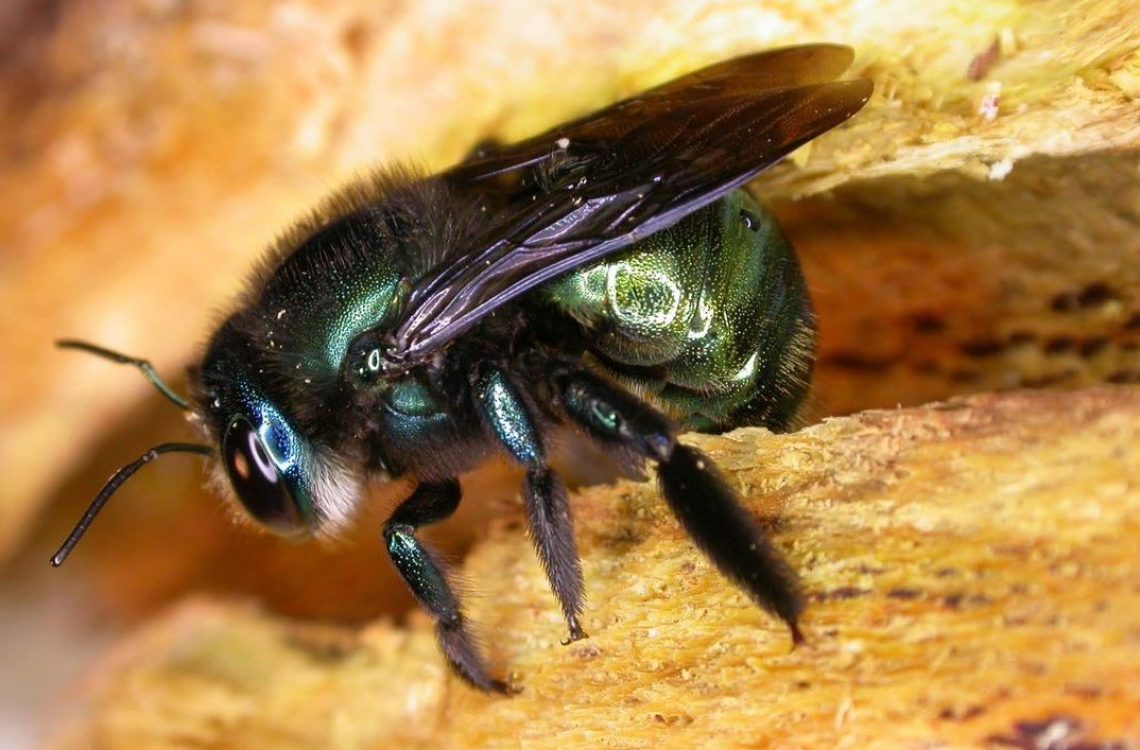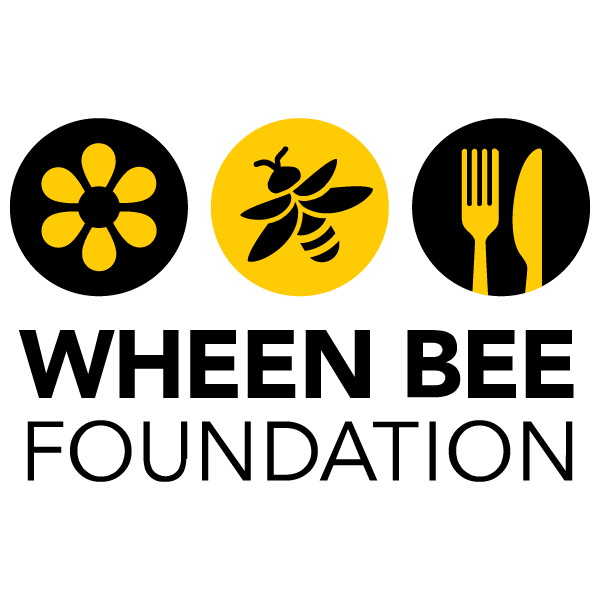News & Media

The Green Carpenter Bee
- June 3, 2022
- | News & Media
The Wheen Bee Foundation has been supporting a dedicated team from South Australia to track and support the bee’s fortunes since the bushfires. They are Remko Leijs from the South Australian Museum, Katja Hogendoorn (The University of Adelaide) and Richard Glatz (D’Estrees Entomology.
The green carpenter bee (Xylocopa aerata) is an iconic, beautiful native species described as a “jewel of nature” for its metallic green and gold colouring. Carpenter bees are so named because they excavate their own nests in wood.
With a body length of up to two centimetres, it is among the largest native bees in southern Australia.
It is an important pollinator for several species of Australian native plants. Many native plants, such as guinea flowers, velvet bushes, Senna, fringe, chocolate and flax lilies rely completely on buzz-pollinating bees for seed production. Buzz pollinators vibrate the flower to shake the pollen out of the anthers. The green carpenter bee is the largest buzz pollinating species in South Australia .
Dr Leijs came to Australia from Utrecht in 1996 to complete his Phd on the evolution of carpenter bees at Flinders University in Adelaide.
Carpenter bees are found on every continent except Antarctica, and probably date back to south east Asia 60 million years ago, Dr Leijs said.
The species went extinct in mainland South Australia in 1906 and Victoria in 1938 after another catastrophic bushfire disaster.
A few exist around Bega in southern NSW, and healthy populations remain around Sydney and in the Great Dividing Range up towards the Queensland border.
The species was last seen in Victoria early in December of 1938 in the Grampians, which burnt completely during the Black Friday fires of January 1939. They have not been seen there since.
Global warming and more frequent fires are an existential threat to Carpenter Bees because they nest in fire-prone dead wood, they need floral resources throughout the year to survive… and they only live for a year.

So if their nests burn before the offspring mature in late summer the adult female may fly away but won’t live long enough to reproduce again.
Green carpenter bees dig their nests in two types of soft wood – the dry flowering stalks of grass trees and large dead Banksia trunks. Grass trees flower prolifically after fire, but the stalks only dry out 2-5 years down the track. Banksias don’t survive fires and take 30 years to grow big enough for the bees to use.
After the bushfires on Kangaroo Island in 2007 Dr Leijs and his colleagues Katja Hogendoorn and Richard Glatz noted that fires seriously impact the amount of nest material for the bees and therefore their ability to reproduce. Since then they worked hard to help the bee population with help from the Wheen Bee Foundation and other organisations.
They developed artificial nesting “stalks” made from balsa wood that mimic grass tree flower stalks and dead Banksia trunk. Volunteers at Kingscote Men’s Shed on the island helped make them for the team… and they worked!
From 2012 until the fire around 300 female carpenter bees had successfully used the artificial stalks to raise their offspring.
To be sure their strategy was working the bee conservation team took occupied nests to the Kingscote vet who x-rayed them and proved the success. During the winter before the fire 150 nests were inspected in the field using a portable X-ray machine provide by members of the South Australian Museum Waterhouse club.
Initially, the artificial stalks produced, on average 4.2 off-spring per year, but in later years this average was much reduced probably due to a number of very dry springs and summers that affected the food resources for the bees.
At the time of the 2020 fires on Kangaroo Island there were more than 150 nests containing mature brood in the stalks. They had been placed at 12 different sites around Flinders Chase National Park to spread risk… but to no no avail. All were burnt.
“We were horrified to see the intensity and speed of the fire that turned our efforts to ash,” Dr Leijs said.
Surveys funded by the Wheen Bee Foundation after the fires found only about 5% of the Green Carpenter Bee’s habitat had survived… mostly in remnants on private property.
After searching for three weeks we found 20 natural nests,” Dr Leijs said “We used to be able to find that many in three hours.” All these are now empty, and artificial nesting stalks installed around the island show no signs of life.
“We didn’t see any bees flying during our checks this season. October and November is the prime season when they do all their foraging.
“Locals used to photograph and send in carpenter bee sightings, but there haven’t been any seen since the 2020 fires.”
Dr Leijs and his colleagues can now only wait to see if a handful of bushfire survivors can repopulate the island.
Sadly the Kangaroo Island population was struggling even before the devastating 2020 bushfire, after several dry years.
Asked about their chances of survival now, Dr Leijs said: “The future looks grim.”
The Green Carpenter Bee is not the only species facing this problem. Many Australian plants and animals are not resilient to the high frequency fires associated with global warming.
“The ecological importance of longtime unburnt forest needs urgent recognition, as increased fire frequency – both of natural and “managed” fires – is likely to drive a suite of species to extinction,” Dr Leijs warns.
“For Kangaroo Island, this could include several small mammal species, the glossy black cockatoos and a range of invertebrate species including the Green Carpenter Bee.”
“Given the expected increase in fire frequency and intensity associated with climate change, it’s time we recognise fire-vulnerable species as a category that requires urgent habitat protection,” Dr Leijs said.
One glimmer of hope is that Dr Leijs has done genetic analysis and found that the green carpenter bees around Sydney, although genetically distinct, belongs to the same species as the Kangaroo Island bees.
They hope that in a few years when the post-fire grass tree stalks dry out on Kangaroo Island and with his team’s successful application of artificial nesting stalks the Sydney branch of the species could be bred-up and reintroduced to Kangaroo Island… and possibly even the Grampians in Victoria where they are known to have thrived in the past.
(Picture credit: Remko Leijs)
Share this post
The Latest Buzz newsletter
View our past newsletters and subscribe below.
Subscribe
Subscribe to our newsletter to keep informed about our important work. We’ll also keep you up-to-date with all the latest news, industry information and events.



